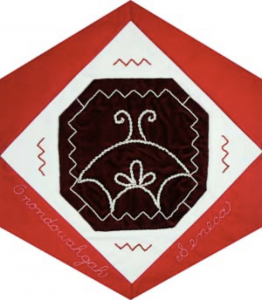Seneca

The Block
Block-maker Towanna Miller (of the Kahnawake Reserve in Québec), wanting to stay true to Seneca heritage, carefully searched their pattern collection housed at the Kahnawake Cultural Centre (an information resource on the Six Nations). She was able to reproduce a piece of Seneca history through her design choice; a simple, yet effective outline of an 18th century hat worn by Chief Joseph Brant on a visit to England’s King George III. Each part of the design, which is worked in white beads on rich, burgundy velvet, is significant. The border represents unity – everyone is connected with the four corners of the globe. Three domes, which are often found in Iroquoian artwork, stand for the past, present and future of the world. The centre dome’s design is the ever-lasting life cycle, everything growing on earth. The large, top dome, above which grows a celestial tree, represents the celestial world, from where the Iroquois people came. The revered celestial tree “provided the Sky Woman with seeds to bring to our world, where Turtle Island (North America) originated.”
Cultural Profile
The Seneca were the largest of the original five members of the Haudenosaunee (or Iroquois) Confederacy, which included the Cayuga, Mohawk, Onondaga, and Oneida. In 1722, the Tuscarora took a seat in the League of the Iroquois Council to create the Six Nations. Within the Confederacy, the Seneca are known as the Elder Brothers and the Keepers of the Western Door. They call themselves Onondowahgah, meaning “People of the Great Hill.” This name comes from their legendary belief that they emerged into this world from under South Hill (near Canandaigua Lake, in what is now New York State). Their ancestral lands include the upper portion of New York State and north into Ontario. They depended mostly on agriculture for food, but also hunted and gathered plants. Women took care of cultivating crops like corn, squash, and beans; a trio that was often referred to as the “Three Sisters.” The spirits of these plants were called De-o-ha-ko, which means the “life supporters.”
Seneca society was organized into eight clans (Turtle, Bear, Wolf, Beaver, Deer, Snipe, Hawk, and Heron), each further divided, along matrilineal lines, into two moieties. Each moiety was led by a chief who was guided in his duties by a council of men. Seneca men were distinguishable by the placement of the feather on their gustoweh, a typical Iroquoian hat. Unlike their brothers, the Cayuga, whose feathers tilted downward, the Seneca set their feathers in an upright position.
By 1797 the Seneca had already lost much of their land to white westward expansion and were moving onto reservations. Despite this loss however, they still managed to keep many of their old ceremonies and traditions alive. Today traditional ceremonies and rituals are practised in longhouses that were specially built for these purposes. Many Seneca in Canada make their home on the Six Nation Reserve situated on the banks of Ontario’s Grand River.
Sponsor: Arthur & Shirley Charbonneau
